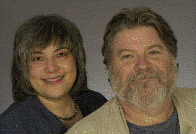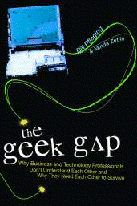The Mad Serb's Dream Comes True at Last
One of the most heartbreaking stories in The Geek Gap is that of Nikola Tesla, a man for whom the term "mad genius" could have been invented.
Tesla, a Serb born in Austria-Hungary, arrived in New York in 1884 with little money and few possessions, beyond a letter of introduction to Thomas Edison, whose new-fangled DC electricity was all the rage at that time. Tesla invented not only alternating current (AC) which we all use today, but also the radio, long before Marconi ever transmitted his first message--"S"--across the Atlantic.
Tesla himself benefited little from his own genius. Promised a huge bonus if he could solve some engineering problems for Edison, he succeeded, only to be told the promise had been a joke. Tesla quit in a huff and went to work repairing sidewalks.
Eventually, he hooked up with Edison rival George Westinghouse, who saw the potential of AC and began promoting it as a preferable alternative to DC. When the ensuing "current wars" between Westinghouse and Edison left Westinghouse financially on the ropes, Tesla magnanimously tore up his contract with Westinghouse, renouncing his right to benefit financially from his own invention. Westinghouse, of course, went on to build an empire that survives today, while Tesla died nearly penniless in 1943 in a cheap hotel room.
As soon as he died, Yugoslavian and U.S. government agents arrived at his hotel room to make off with his papers and notes. They recognized that, nutty though he was, and bad as he was at the business end of inventing, Tesla's was a rare mind that could clearly see what technology could do long before it became reality.
One of the things he saw, but was never able to get enough funding to build, was a tower designed for the transmission of electricity. That's right: in Tesla's vision, charging your battery or powering your electrical device would no longer require wires connected by plugs to electrical outlets, but could simply be done by pulling power waves out of the air, the same way we do with music when we switch on a radio. Tesla always swore it could be done. "It is a simple feat of electrical engineering, only expensive," he wrote.
Cut to summer, 2007. Tesla's name has been popping up again because some researchers at the Massachusetts Institute of Technology (MIT) seem to have built their own smaller-scale version of what Tesla had in mind, transmitting enough electricity from one coil to another across a room (and, harmlessly, through a crowd of researchers sitting between them) to power a 60-watt light bulb. For the moment, the most promising application seems to be getting rid of the tangle of wires and wall warts that plague the area around any computer setup or entertainnent.
But, as the technique is perfected, larger-scale uses are coming, and "now is a good time to start thinking about commercializing it," according to Marin Soljacic, the professor who led the MIT team that made the breaktrhough. (Soljacic is Croatian, which makes you wonder if there's some kind of electrical-engineering-genius-juice mixed in with the water in the former Yugoslavia.)
Even without the MIT breakthrough, transmitted power has been tip-toeing into everyday use, on RFID tags, for instance, which usually don't carry batteries, but instead get all the power they need from the radio waves that come looking for them.
And British startup SplashPower is selling technology that allows users to recharge such items as mobile phones and digital cameras through magnetic induction, simply by setting them on a mat. These devices have to be fitted with a tiny SplashPower receiver to work on the SplashPower mat, so adoption may take some time.
But magnetic induction is already commonly in use in other items including a new kitchen stove that's extremely cool--both metaphorically and literally--the heating surface doesn't get hot! (I want one!) And electric toothbrushes. I remember being quite fascinated with my Oral-B, whose plastic handle sits on plastic charger with no metal contact for the transmission of power, but Bill understood right away how it worked.
Someday soon, we will be free of wires, and there will be room-wide, then later on, city-wide power transmission. Tesla always knew it could be done.
Tesla, a Serb born in Austria-Hungary, arrived in New York in 1884 with little money and few possessions, beyond a letter of introduction to Thomas Edison, whose new-fangled DC electricity was all the rage at that time. Tesla invented not only alternating current (AC) which we all use today, but also the radio, long before Marconi ever transmitted his first message--"S"--across the Atlantic.
Tesla himself benefited little from his own genius. Promised a huge bonus if he could solve some engineering problems for Edison, he succeeded, only to be told the promise had been a joke. Tesla quit in a huff and went to work repairing sidewalks.
Eventually, he hooked up with Edison rival George Westinghouse, who saw the potential of AC and began promoting it as a preferable alternative to DC. When the ensuing "current wars" between Westinghouse and Edison left Westinghouse financially on the ropes, Tesla magnanimously tore up his contract with Westinghouse, renouncing his right to benefit financially from his own invention. Westinghouse, of course, went on to build an empire that survives today, while Tesla died nearly penniless in 1943 in a cheap hotel room.
As soon as he died, Yugoslavian and U.S. government agents arrived at his hotel room to make off with his papers and notes. They recognized that, nutty though he was, and bad as he was at the business end of inventing, Tesla's was a rare mind that could clearly see what technology could do long before it became reality.
One of the things he saw, but was never able to get enough funding to build, was a tower designed for the transmission of electricity. That's right: in Tesla's vision, charging your battery or powering your electrical device would no longer require wires connected by plugs to electrical outlets, but could simply be done by pulling power waves out of the air, the same way we do with music when we switch on a radio. Tesla always swore it could be done. "It is a simple feat of electrical engineering, only expensive," he wrote.
Cut to summer, 2007. Tesla's name has been popping up again because some researchers at the Massachusetts Institute of Technology (MIT) seem to have built their own smaller-scale version of what Tesla had in mind, transmitting enough electricity from one coil to another across a room (and, harmlessly, through a crowd of researchers sitting between them) to power a 60-watt light bulb. For the moment, the most promising application seems to be getting rid of the tangle of wires and wall warts that plague the area around any computer setup or entertainnent.
But, as the technique is perfected, larger-scale uses are coming, and "now is a good time to start thinking about commercializing it," according to Marin Soljacic, the professor who led the MIT team that made the breaktrhough. (Soljacic is Croatian, which makes you wonder if there's some kind of electrical-engineering-genius-juice mixed in with the water in the former Yugoslavia.)
Even without the MIT breakthrough, transmitted power has been tip-toeing into everyday use, on RFID tags, for instance, which usually don't carry batteries, but instead get all the power they need from the radio waves that come looking for them.
And British startup SplashPower is selling technology that allows users to recharge such items as mobile phones and digital cameras through magnetic induction, simply by setting them on a mat. These devices have to be fitted with a tiny SplashPower receiver to work on the SplashPower mat, so adoption may take some time.
But magnetic induction is already commonly in use in other items including a new kitchen stove that's extremely cool--both metaphorically and literally--the heating surface doesn't get hot! (I want one!) And electric toothbrushes. I remember being quite fascinated with my Oral-B, whose plastic handle sits on plastic charger with no metal contact for the transmission of power, but Bill understood right away how it worked.
Someday soon, we will be free of wires, and there will be room-wide, then later on, city-wide power transmission. Tesla always knew it could be done.



0 Comments:
Post a Comment
Subscribe to Post Comments [Atom]
<< Home